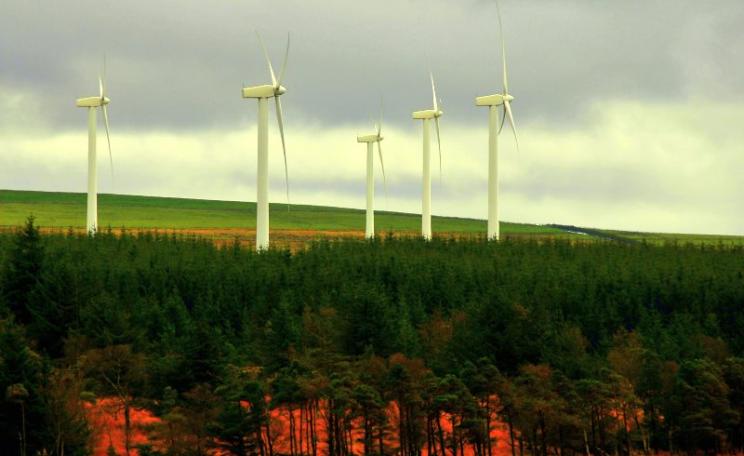Given that the UK's monthly wind power variation more closely matches UK electricity demand than is the case in Germany, we could even beat the Germans to an all-renewable electricity supply.
Football fans, impressed by Germany becoming the first European team to win the World Cup in South America, are asking: how did Germany do it?
Electricity consumers, environmentalists and politicians should be asking the same question about another impressive German achievement: reducing the wholesale price of electricity at a time when energy costs are rising. There are similarities in both achievements.
The German football team is strong because their national league promotes the development of indigenous talent rather than importing costly foreign players. The lower wholesale electricity price in Germany results from developing indigenous renewable power resources.
In contrast UK energy policy is dominated by a perceived need for expensive foreign-owned, nuclear power. The German football authority implemented its new youth development scheme in 2000. That same year the German government introduced feed-in-tariffs to support the renewables.
In football, the power a player applies to the ball and the timing of the kick are crucial. If national electrical power demand is to be met then the timing of the power supply is vital.
The importance of teamwork was apparent to all who watched Germany win 7-1 against Brazil's talented individuals. It is less well known that an experiment in Germany in 2006 demonstrated how wind power, solar photovoltaic (PV) power and biogas electricity generation could work together to satisfy the German electricity demand all year.
Indigenous resources lead to lower wholesale electricity prices.
Electricity costs more during the day when demand is high and expensive generators supply the extra electricity. In Germany, as in the UK, the daytime demand for electricity is highest around noon, summer and winter, when lunch is being prepared.
In winter months there is a high evening peak around suppertime in both countries. As we will see, PV power output is highest at noon when the sun is highest in the sky. It is close to the peak in the daytime electricity demand.
In Germany in 2007 the wholesale cost of electricity was 30% higher at its maximum around noon than at night, as can be seen from Figure 1 (above right). This difference has steadily declined as the amount of PV power connected to the grid has increased.
The fall is less is winter, as expected because the sun does not get so high in the sky at noon, but the wholesale price has been falling in winter too. Electricity from PV and wind costs less than from conventional generators when it is supplied. There are no fuel costs and only small operational costs.
This trend has continued. Thanks, primarily, to the renewable contributions, the yearly average wholesale price of electricity on the German grid declined from 2011 to 2013.
It's all about timing
The way that PV electricity supply satisfies the daytime peak demand for electricity in Germany can be seen from Figure 2 (above right). This shows the electrical power (in MW) consumed by all the electricity users connected to the German grid in a typical early spring week, before Easter.
Given that the UK's monthly wind power variation more closely matches UK electricity demand than is the case in Germany, we could even beat the Germans to an all-renewable electricity supply.
The seven peaks do not represent the goals Germany scored against Brazil - rather the maximum electricity demand for the four working days and three holidays.
The golden, olive and grey areas show the power provided by solar PV, wind and conventional generators respectively. The operators of the German grid managed to keep all the lights on in Germany all week, whatever nature threw at them in terms of the yellow and olive contributions.
They managed to do so by adjusting the height of the grey area that represents the contribution of the conventional electricity generators.
The maximum of the yellow solar contribution is close to the peak in demand. In addition the variation of the PV contribution throughout the daytime peak is similar to that of the demand. Germans go to and from school and work at times very much influenced by the sun's cycle.
This is confirmed by the white lines between the yellow and olive contributions. These are reasonably flat most days whether the PV contribution is high as on Wednesday and Thursday or low as on Monday, Tuesday and Good Friday.
Examples of the complementary nature of PV and wind power can be seen in Figure 2 (above right). On Monday, Tuesday and Good Friday the solar contribution was low due to cloud cover, but the wind provided more power, as expected. Wednesday was a still, sunny day when wind power made its smallest contribution, but the solar contribution was high.
Weather forecasts can do a good job in predicting the amount of cloud cover and the strength of the winds so grid operators have a good idea what to expect.
Teamwork: the complementary nature of wind, PV and biogas electricity generation
Biogas electricity generators provide the ideal back-up to wind power and PV power. They can change their power output in minutes if required.
In 2006, the German Kombikraftwerk (combined power plant) experiment showed that the scaled-down electrical power demand on the German grid could be met, throughout the year, by the actual output of wind and PV generators with back-up in real time from biogas generators.
The complementary nature of wind and PV power generation was demonstrated by 78% of the scaled German electricity demand being met by these two alone over the year. Biogas supplied 17% of the power and only around 5% of electrical storage was necessary.
If the biogas comes from one of the many forms of waste there are three other advantages: the source is indigenous, the electricity is in general cheaper than from natural gas and has a far lower carbon footprint.
Biogas from waste often avoids the methane (a far worse greenhouse gas than carbon dioxide) emitte to the atmosphere were the waste left to rot.
Could the UK achieve these results?
The UK's onshore wind, PV and biogas from waste resources are similar to Germany's. Our offshore wind power resources are far larger. We have only considered the three leading players in the renewable energy team.
And like football, it's an 11-a-side game. In the UK the other eight members of the team also have great potential: wave, tidal, geothermal, hydro, biomass, plus air-source, ground-source heat pumps and energy efficiency.
Sadly, the coalition government's response to the encouraging rise in UK solar farms was to remove the successful subsidy. The conservatives also plan to oppose onshore wind turbines in their 2015 election campaign.
The government announced in the Queen's speech that it would be giving even more support to fracking natural gas. Given the uncertain yield, fracking is likely to give more expensive electricity than biogas. It will definitely have a far higher carbon footprint than biogas from waste.
The renewables are very popular with the electorate. The government's own survey showed that public support for solar photovoltaic (PV) electricity stands at 85% and onshore wind at 70%, while fracking is only supported by 29%.
The simple truth - with lots of renewables, prices fall
The popularity of renewables would rise further were the public aware that the wholesale price of electricity in Germany is falling - and customers are the beneficiaries.
The public is most concerned about the retail price of electricity. This is larger than the wholesale price due to a number of factors including distribution costs, distribution company profits and a small contribution from levies that support the renewables.
In the UK the subsidies for all the renewable energy sources added together are smaller than for natural gas alone - even though the fossil fuel industry is established, booming and has no need of subsidies.
Some of these gas subsidies should be transferred to supporting the renewables to reduce the wholesale price of electricity. The rest should be scrapped to improve government finances.
The government's own Committee for Climate Change recommends a carbon footprint below 50 gCO2/kWh for electricity generation by 2030. All renewable electricity generators fall below this limit. The evidence from Germany and the extent of our renewable energy resources suggests this limit could safely be imposed here and now.
With the UK's massive renewable resources, we could beat Germany
Any political party that was brave enough to stand up to the fossil fuel industry and announce it would impose such an environmental standard could expect strong public support. It would mean strong action on global warming and lower electricity bills.
Given that the UK's monthly wind power variation more closely matches UK electricity demand than is the case in Germany, we could even beat the Germans to an all-renewable electricity supply.
Keith Barnham is Emeritus Professor of Physics at Imperial College London, and author of The Burning Answer: a User's Guide to the Solar Revolution, published by Weidenfeld and Nicolson. ISBN 01373-463-822.






